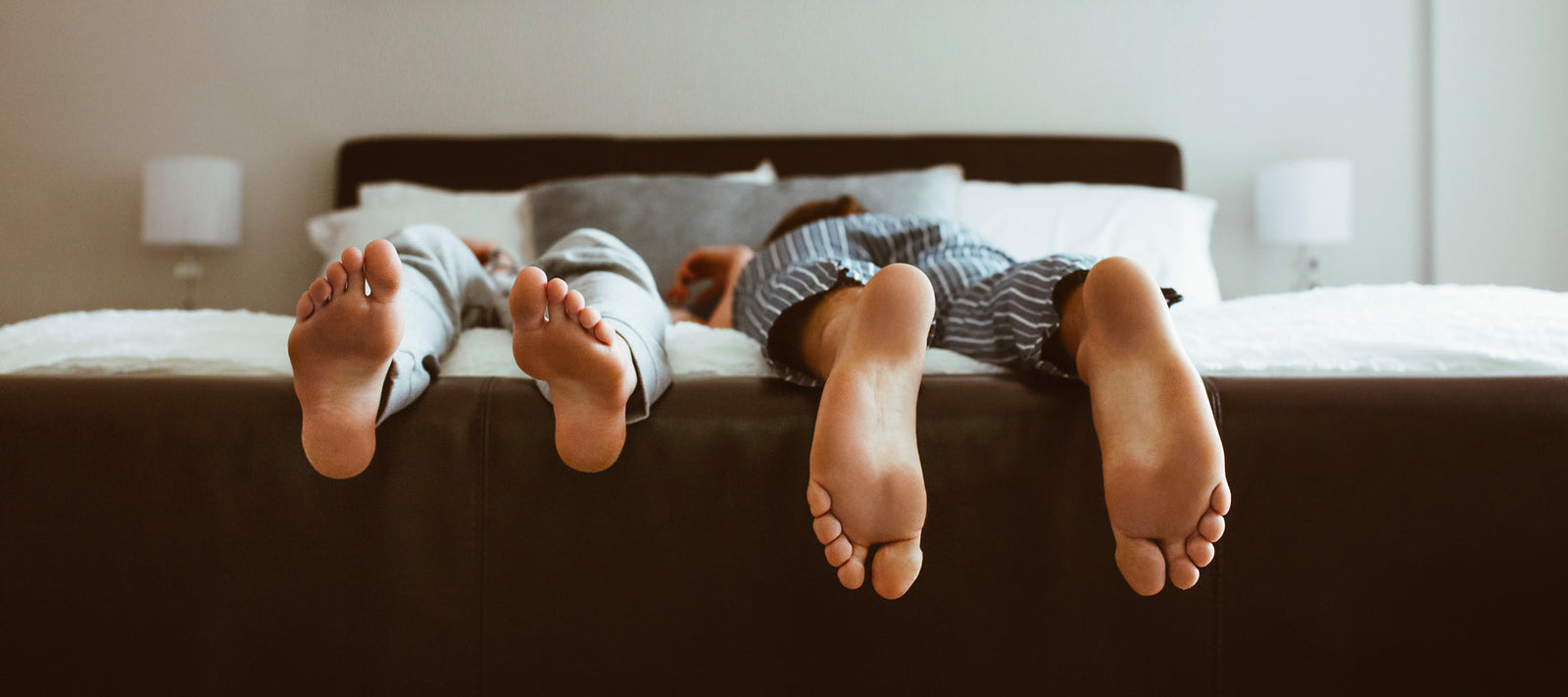Your Cart is Empty
Buy now, pay later or in 3 with Klarna
Get free shipping by subscribing to newsletter!
Fast shipping from our warehouse in the UK!
Buy now, pay later or in 3 with Klarna
Get free shipping by subscribing to newsletter!
Fast shipping from our warehouse in the UK!

4 Best Positions for Sleeping
There’s nothing worse than thinking you got a good night’s rest and then waking up with a crick in your neck. You’re immediately hit with a jolt of pain as soon as you get out of bed and spend the day with ice on your neck. Ouch. Sleeping in the wrong position will leave you in pain for days. Which is why it’s so important to sleep in a comfortable, supportive position.
We all know how crucial it is to get a good night’s rest. Getting enough sleep keeps you focused and alert throughout the day, boosts your mood, and improves your overall health. In order to get a good night’s rest, you need to find the best way to sleep. Finding a proper way to sleep can reduce stress on your spine and relieve stiffness in your back, arms, and shoulders. If you’re struggling with how to sleep comfortably at night, you may have to take a look at your sleeping position. The way you’re sleeping could be doing much more harm than good.
In this article, we’ll be discussing the various sleeping positions, tips to help you find the best way to sleep, and more. Finding a comfortable sleeping position will improve your quality of sleep more than you can imagine. Prioritize your sleep and figure out the best sleeping position for you.
Which Position Should I Sleep in?
You may be wondering: what is the best sleeping position? There are many healthy sleeping positions to choose from. The best one for you depends on what’s most comfortable, as well as other factors such as pregnancy, back/shoulder pain, heartburn/acid reflux, and more. So before you choose a sleeping position, make sure you do some research to find out one that will actually benefit you. These are the various sleeping positions to choose from:

Fetal position
The fetal position is one of the most popular sleeping positions. In the fetal position, you sleep with your legs bent and curled towards your torso. There are several benefits of sleeping in the fetal position, including:
- Relieves lower back pain
- Can reduce snoring
- Improves circulation for pregnant women
If you choose to sleep in the fetal position, make sure your body is loose and relaxed when you curl up. If this position hurts your hips, try placing a pillow in between your knees to reduce some of the pressure. You want your position to be as loose as possible, as sleeping in a tight fetal position can lead to soreness.

Side sleeping
With the side sleeping position, you lay on either your left or right side with a pillow underneath your head. You can keep your arms and hands below your face and neck. Side sleeping has many benefits, especially if you sleep on your left side. Some of these benefits include:
- Reduces heartburn and snoring
- Beneficial for pregnant women
- Relieves back pain
Side sleeping is also a comfortable position for older adults as the flexibility of your spine decreases as you get older. Side sleeping is ideal for people who have acid reflux or sleep apnea. It is also a good position for pregnant women as it can relieve some of the pressure of a growing belly. Sleeping on the left side promotes healthy blood circulation to the fetus, uterus, kidneys, and heart.
If you do choose to sleep on your side, make sure you choose a supportive pillow to reduce neck and back pain. You can also try placing a pillow in between your legs or under the small of your back for added comfort.

Stomach sleeping
Stomach sleeping is the least common sleeping position. If you sleep on your stomach, you should sleep with a very thin pillow or no pillow at all. Using a thicker pillow will angle your head and neck in an uncomfortable position. While sleeping on your stomach has some benefits, it is really not the best for your health. The benefits of stomach stomach sleeping are:
- Can relieve snoring by opening up your airway
- Lowered risk of sleep apnea
Besides these two benefits, which can also be achieved with other positions, stomach sleeping can actually lead to a number of health problems. Pregnant women and people with neck and back pain should avoid stomach sleeping as it puts more pressure on your nerves which can cause numbness or tingling. Sleeping on your stomach can also cause facial wrinkles because your face is pressed into your pillow. Stomach sleeping provides the least back support and increases pressure on the spine.

Back sleeping
Back sleeping is a popular sleeping position because it has many benefits. With back sleeping, you lay flat on your back with a pillow underneath your head. Back sleeping keeps your head, neck, and spine in a neutral position so it reduces the chance of you waking up with neck pain. There are many other benefits of back sleeping, such as:
- Reduces lumbar spinal pain
- Relieves neck pain
- Helps with nasal congestion
- Keeps your spine aligned
- Reduces heartburn
- Puts less pressure on your internal organs
Back sleeping is also ideal if you’re looking to avoid wrinkles and irritated skin. When you sleep on your back, your face doesn’t come into direct contact with your pillow, which minimizes the chance of developing wrinkles. If you have heartburn, try sleeping on your back with your head slightly elevated with a small pillow. You can also try putting a pillow behind your knees to reduce back pain and pressure on your spine. Propping yourself up with an extra pillow also helps to relieve congestion.
Tips to Help You Find The Best Way to Sleep
So, what is the best way to sleep? It ultimately depends on the type of sleeper you are and what you’re looking to achieve. The best sleeping position is different for everyone, so it’s important to consider your unique needs. If you have trouble staying asleep or falling asleep, check out these tips to help you find the best way to sleep:
1. Find the right pillow
When you think of a bed, you think of a pillow. But pillows aren’t just used for your head and neck. The right type of pillow can provide additional support and completely transform your sleeping experience. Using an additional pillow in bed can help keep your spine in the proper position. When looking for the right pillow, you want to think about the way you sleep. The right pillow should provide support for your neck and not cause tension on your neck, back, and shoulders. You want to use a pillow that will keep your neck aligned with your chest and lower back for optimal comfort.
2. Achieve alignment
It’s crucial to try to keep your ears, shoulders, and hips aligned while you sleep. There are certain ways you can achieve alignment depending on your sleeping position. If you sleep on your stomach, make sure to put a small pillow under your stomach and pelvis area to keep your spine aligned. If you sleep on your back, you should put a small pillow under the back of your knees to support the curve of your lower back and reduce stress on your spine. If you sleep on your side, put a pillow in between your knees to reduce stress on your hips and lower back. Putting a pillow in between your knees will also help to stop your upper leg from pulling your leg out of alignment when sleeping in the side position. If you twist and turn at night, try to move your entire body, rather than just one portion. Keep your knees in toward your chest as you turn. Doing this will help to keep your body aligned as you sleep.
3. Choose a good mattress
Getting good sleep isn’t just about the type of pillow you use, your mattress plays a big role as well. The right mattress will help you get comfortable and relaxed as you sleep. You want to choose a mattress that supports the natural curve of your body so you can wake up feeling well rested and pain free.
4. Consider your unique needs
At the end of the day, the best sleeping position is ultimately up to you. Different sleeping positions help with different needs. The right sleeping position can help to reduce acid reflux, snoring, back pain, headaches, wrinkles, and more. So before deciding on a sleeping position and sticking to it, consider your own unique needs. What are you looking to get out of your sleeping experience? Do you want reduced back pain? Or do you just want to improve your sleep in general? Take some time to figure out exactly what you want before choosing the best way to sleep.

Takeaways
Finding the best way to sleep isn’t necessarily an easy process. There are various healthy sleeping positions, so you have to figure out the one that works for you. If you’re still struggling with achieving good sleep, MedCline offers various products as a way to improve sleep. If you suffer from shoulder pain, MedCline has a shoulder pain relief system that can help you sleep comfortably on your side. MedCline also has an acid reflux relief system and a therapeutic body pillow, both of which are designed to help you get a better night’s rest. With MedCline’s uniquely designed pillows, you’ll never have to worry about waking up in the middle of the night in pain again.



